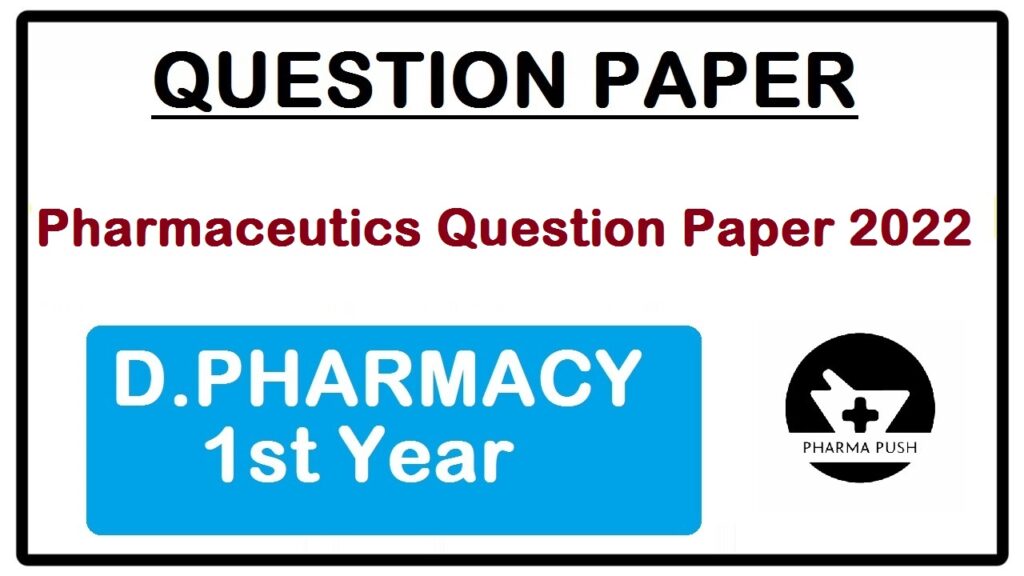The specific questions considered most important for D.Pharma (Diploma in Pharmacy) 1st Year can vary depending on the curriculum and course structure of the institution you are attending. However, I can provide you with a list of general topics and questions that are commonly covered in the first year of a D.Pharma program.
Please note that these are general areas of study, and the actual questions may vary:
PHARMACEUTICS
These are following Important question of Pharmaceutics.
- Introduction to Indian Pharmacopoeia and Salient features of Indian Pharmacopoeia.
- Discuss the importance of pharmaceutical incompatibilities.
- Introduction to BP, USP, NF and Extra Pharmacopoeia. [Short Explanation]
- Packaging materials: Types, Selection criteria of Packing Materials, advantages and disadvantages of glass, plastic, metal, rubber as packaging materials. [Most Important Chapter]
- Pharmaceutical aids: Organoleptic (Colouring, flavouring,and sweetening) agents
- Preservatives: Definition, types with examples and uses.
- Size reduction: Hammer mill and Ball mill [One Question]
- Seives and standards of seive and what are size separation?
- Mixing: Double cone blender, Triple roller mill and Silverson mixer homogenizer [One Question]
- Filtration: Define filtration and theory of filtration, membrane filter and sintered glass.
- Drying: Working of fluidized bed dryer
- Extraction: Definition, Classification in deeply , applications
- Tablets – coated and uncoated, various modified tablets with example
- Capsules – hard and soft gelatine capsules with example
- Quality control and quality assurance: Definition and difference
- Novel drug delivery systems: Introduction, Classification with examples, advantages, and challenges [One Questions]
PHARMACEUTICAL CHEMISTRY
These are following Important question of Pharmaceutical Chemistry.
- Introduction to Pharmaceutical chemistry: Scope and objectives
- Sources and types of errors: Accuracy, precision, significant figures [one or more questions]
- Impurities in Pharmaceuticals: Principle and procedures of Limit tests for chlorides, sulphates, iron, heavy metals and arsenic. [One or More but Most Imp. 100%]
- Volumetric analysis: Acid-base titration, non-aqueous titration, precipitation titration, complexometric titration, redox titration [One questions 100%]
- Gravimetric analysis: Principle and method [Most Imp.]
- Medicinal gases: Carbon dioxide, nitrous oxide, oxygen [One questions Imp.]
- Definition of All Chapter Topic With Brand Name Example, Universal Side effect, Use, and *Drug Name Structure.
PHARMACOGNOSY
These are following Important question of Pharmacognosy.
- Definition and Scope of Pharmacognosy
- Explain the sources and classification of drugs obtained from natural sources.
- Classification of drugs [Most Imp.]
- Alphabetical
- Taxonomical
- Morphological
- Pharmacological
- Chemical
- Chemo-taxonomical
- Different methods of adulteration of crude drugs or Evaluation of crude drugs [One question Most Imp.]
- Brief outline of occurrence, distribution, isolation, identification tests, therapeutic activity and pharmaceutical applications of alkaloids, terpenoids, glycosides, volatile oils, tannins and resins. [Most Imp. 1000000%]
- Plant fibres used as surgical dressings: Cotton, silk, wool and regenerated fibres [Most Imp. 10000% One or More]
- Basic principles involved in the traditional systems of medicine like: Ayurveda, Siddha, Unani and Homeopathy
- Basic principles involved in the traditional systems of medicine like: Ayurveda, Siddha, Unani and Homeopathy
- Herbs as health food: Brief introduction and therapeutic applications of – Nutraceuticals, Antioxidants, Pro-biotics, Pre-biotics, Dietary fibres, Omega-3-fatty acids
SOCIAL PHARMACY
These are following Important question of Social Pharmacy.
- Introduction to Social Pharmacy: Definition and Scope
- Role of Pharmacist in Public Health.
- Concept of Health – WHO Definition, various dimensions, determinants, and health indicators.
- Introduction to Millennium Development Goals, Sustainable Development Goals, FIP Development Goals [Most Imp.]
- Importance of breastfeeding.
- Demography and Family Planning
- Overview of Vaccines and types with Example
- Drug of misuse and abuse – NDPS, alcohol and tobacco product.
- Basics of Nutrition – Macronutrients and Micronutrients and Nutrition deficiency diseases
- Balanced diet, Malnutrition.
- Effects of artificial ripening
- Introduction of food safety, adulteration of food, Dietary supplements and Drug-Food Interactions
- Causative agents, epidemiology and clinical presentations of the following communicable diseases
- National Health programs in India, their objective and function.
HUMAN ANATOMY AND PHYSIOLOGY
These are following Important question of Human Anatomy and Physiology.
- Scope of Anatomy and Physiology
- Definition of various terminologies
- Structure of Cell: Components and its functions [Most Imp.]
- Define Tissues, Epithelial tissue and connective tissue.
- Disorders of joints
- Define Bones with structure and its function
- Composition and functions of blood and Mechanism of Blood Clotting [Most Imp.]
- Characteristics and functions of RBCs, WBCs, and platelets
- Anatomy and Physiology of heart
- Write BP and its regulation.
- Write Anatomy and Physiology of respiration and their function.
- Physiology of Respiration and its mechanism.
- Anatomy and Physiology of the GIT and its function.
- Physiology of digestion and absorption.
- Anatomy and functions of accessory glands
- Anatomy and Physiology of Sympathetic and Para-Sympathetic Nerve system.
- Anatomy of respiratory organs and their functions.
- Draw the well labeled structure of Eye/Ear.
- Anatomy and Physiology of Urinary System.
- Physiology of Urine Formation.
- Anatomy of male and female reproductive system
- Physiology of menstruation
- Pregnancy and parturition
